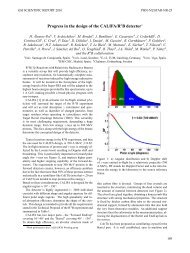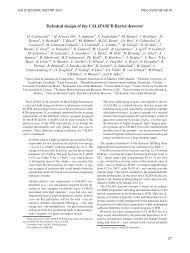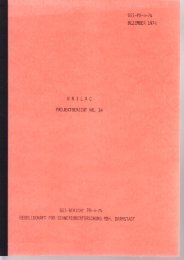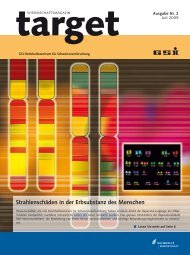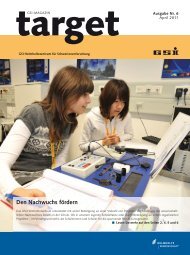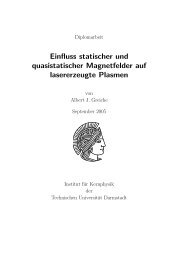download block - GSI Helmholtzzentrum für Schwerionenforschung
download block - GSI Helmholtzzentrum für Schwerionenforschung
download block - GSI Helmholtzzentrum für Schwerionenforschung
You also want an ePaper? Increase the reach of your titles
YUMPU automatically turns print PDFs into web optimized ePapers that Google loves.
NUSTAR-SHE-05 <strong>GSI</strong> SCIENTIFIC REPORT 2009<br />
174<br />
<strong>GSI</strong>Template2007<br />
The capture process and first steps to cold fusion<br />
S. Heinz, V. Comas, S. Hofmann, D. Ackermann, J. Heredia, F.P. Heßberger, J. Khuyagbaatar,<br />
B. Kindler, B. Lommel, and R. Mann<br />
<strong>GSI</strong>, Darmstadt, Germany<br />
The synthesis of heavy elements in cold fusion reactions<br />
using lead and bismuth targets reveals maximum crosssections<br />
for central collisions at energies below the barrier<br />
predicted by the Bass model. The two-centre shell model<br />
[1] gives an approach to explain fusion at such low energies.<br />
It assumes that the nucleons move in a potential<br />
which is formed by combining the potentials of the individual<br />
nuclei. In central collisions at near-barrier energies<br />
the relative velocities and angular momenta are small and<br />
the valence nucleons can move between the reaction partners<br />
as soon as the outer orbits come into contact. We<br />
investigated the applicability of the two-centre shell<br />
model by following the capture process and first steps to<br />
the compound nucleus in the superheavy system 64 Ni +<br />
207 Pb (Zproj + Ztarget = 110). This was done by studying<br />
transfer products with proton numbers beyond the target<br />
proton number, which have been created under the same<br />
kinematical conditions which result in maximum yields of<br />
fusion products, namely, in central collisions and at nearbarrier<br />
energies.<br />
The experiment was performed at the velocity filter SHIP<br />
[2] which allows the detection of reaction products at angles<br />
of (0 ± 2)°. We measured at beam energies of 4.80,<br />
5.00, 5.20, 5.40, 5.53 and 5.92×A MeV. We detected several<br />
transfer products with proton numbers 84 ≤ Z ≤ 88<br />
via their α-decays. Figure 1c shows the excitation functions<br />
representatively for the isotopes 211 Po, 212 At, 213 Rn,<br />
213 Fr and 214 Ra (Z = 84 to 88). The excitation functions<br />
for isotopes with Z = 84, 85 and 86 are rather narrow<br />
(FWHM = 15 MeV) with maxima located below the Bass<br />
barrier (arrows). They are comparable to those from cold<br />
fusion reactions leading to superheavy elements after oneneutron<br />
evaporation (figs. 1a and b). At low energies fusion<br />
or transfer is hindered by the Coulomb barrier while<br />
towards higher energies other evaporation or fission<br />
channels open and lead to the decrease of the yield. The<br />
location of the maxima corresponds to a distance of ≥ 14<br />
fm between the nuclear centres, which just allows for the<br />
contact of the surfaces. According to the two-centre shell<br />
model this is sufficient to start the exchange of valence<br />
nucleons between the cores. For transfer products with Z<br />
> 86 the maxima of the excitation functions are located at<br />
higher energies and their half-widths are larger which<br />
points to higher excited primary products in comparison<br />
to the previous case. They are comparable to fusion excitation<br />
functions for evaporation channels with more than<br />
one nucleon. If and to what extent also the occupation of<br />
specific neutron and proton shells influences the capture<br />
process will be subject to future experiments.<br />
All observed transfer products originate from deep inelastic<br />
reactions. This is reflected by the total kinetic energies<br />
Figure 1. Excitation functions for 1n evaporation channels<br />
in the cold fusion reactions 58 Fe + 208 Pb and 64 Ni +<br />
208 Pb (a, b) and for different isotopes produced in transfer<br />
reactions in 64 Ni + 207 Pb collisions (c). The energy scale<br />
on the abscissa gives the excitation energy of the compound<br />
nuclei 266 Hs and 271 Ds.<br />
in the exit channel, which are independent of the bombarding<br />
energy and have values slightly below the Viola<br />
energy.<br />
The massive transfer of nucleons, which we observed at<br />
very low beam energies, has also an applicatory aspect.<br />
The low beam energies lead to transfer products at low<br />
excitation energies. This enhances their survival probability<br />
against particle evaporation and fission. Therefore,<br />
such transfer reactions could be used to create new isotopes<br />
of heavy nuclei, especially on the neutron-rich side<br />
of the nuclear chart.<br />
References<br />
[1] D. Scharnweber, W. Greiner, and U. Mosel, Nucl.<br />
Phys. A 164, 257 (1971).<br />
[2] S. Hofmann and G. Münzenberg, Rev. Mod. Phys. 72,<br />
733 (2000).





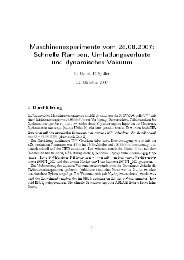
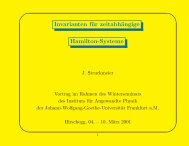
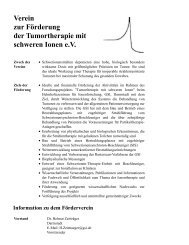
![GS I -P-]-17 - GSI Helmholtzzentrum für Schwerionenforschung](https://img.yumpu.com/20698964/1/184x260/gs-i-p-17-gsi-helmholtzzentrum-fur-schwerionenforschung.jpg?quality=85)

